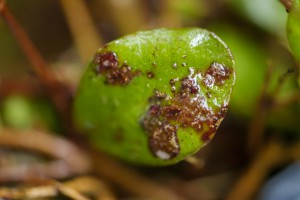Myrtle rust, caused by the fungal pathogen Austropuccinia psidii, infects plants in the myrtle (Myrtaceae) family. In Aotearoa, Myrtaceae include some of our most iconic trees, pōhutukawa, mānuka, kānuka, swamp maire, ramarama, and rōhutu.
Summertime creates ideal conditions for this disease to thrive. In previous summers, the highly susceptible ramarama and rōhutu, both species in the genus Lophomyrtus, were hardest hit. But serious infections have been reported on a broader range of Myrtaceae with each summer that passes following the arrival of the pathogen in 2017.
“Last season, we saw the disease take a toll on swamp maire,” says Dr Mahajabeen (Maj) Padamsee, leader of the Beyond Myrtle Rust research programme. “Anecdotal evidence from our researchers suggests that pōhutukawa have been hit much harder this season than in past seasons.”
Anecdotal evidence is supported by an increase in reports of infected pōhutukawa in Auckland on iNaturalist, a citizen science platform that can be used to report myrtle rust. In addition, a recent survey of pōhutukawa infections completed by University of Auckland students working with researchers at Manaaki Whenua – Landcare Research undertaken across Tāmaki Makaurau showed that some trees are experiencing a particularly high level of infection.
“If this level of infection keeps happening every myrtle rust season, then we could potentially lose some of these trees,” says Dr Padamsee.
The survey also noted infections on buds, flowers and developing seed capsules. “The real worry is that the infection might interfere with seed production,” says Dr Padamsee. “We’ve seen from ramarama and rōhutu that once the bud and seedpods are infected, they don’t go through their reproductive cycle.”
The survey was the first to report myrtle rust on Rangitoto Island. This is particularly concerning given the island supports the world’s largest pōhutukawa forest, with the trees being fundamental to ecosystem health.
Myrtle rust is a slow acting disease. It may be that we don’t see the full extent of myrtle rust impacts for several years. But if the uptick in infection severity in New Zealand, not to mention the extinctions of endemic Myrtaceae being seen in Australia, is anything to go by, this is only the beginning.
“My daughter has learned songs about the pōhutukawa tree at school,” says Dr Padamsee. “I want her to be able to see these trees when she grows up.”
The survey of pōhutukawa in Auckland was undertaken by undergraduate student Faye Hine and PhD student Vladislav Kholostiakov.
![An infected pōhutukawa tree with the yellow spores of the myrtle rust fungus, [Austropuccinia psidii], showing clearly. Image](/assets/News/infected-pohutukawa-leaves__FitMaxWzE1LDE1XQ.jpeg)
![A bud on a pōhutukawa tree clearly showing the [Austropuccinia psidii] infection. Image](/assets/News/infected-pohutukawa-bud__FitMaxWzE1LDE1XQ.jpeg)

![An infected pōhutukawa tree with the yellow spores of the myrtle rust fungus, [Austropuccinia psidii], showing clearly. Image](/assets/News/Infected-pohutukawa-tree-2__FitMaxWzE1LDE1XQ.jpeg)

